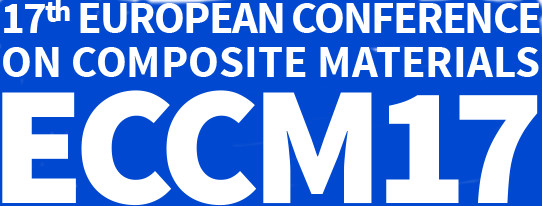

App-Einstellungen:
EFFECT OF MOISTURE ON ELECTRICAL RESISTIVITY OF CNT REINFORCED EPOXY NANOCOMPOSITES
Sima Navabizadeh (Concordia University) Suong V. Hoa (Concordia University) Daniel Rosca (Concordia University)
We investigate the effect of moisture on the electrical resistivity of epoxy containing CNT. The effect of different type, and different concentrations of nanotubes on the rate of diffusion as well as the maximum amount of water absorbed were studied.
EXPERIMENTAL METHODS AND RESULTS FOR THE REDUCTION OF RESIN SHRINKAGE BY THE ADDITION OF NANOPARTICLES FOR INCREASED DIMENSIONAL ACCURACY OF CARBON FIBER REINFORCED PLASTICS
Wibke Exner (German Aerospace Center) Peter Wierach (German Aerospace Center)
Process-induced distortions of carbon fiber reinforced plastics are a result of the resins chemical and thermal shrinkage. The addition of nanoparticles is one way to overcome this problem. Experimental methods and results are presented.
REINFORCEMENT OF COMPOSITE MATERIALS USING ARCHITURED CARBON NANOTUBES – CARBON FIBERS
Fabrice Laurent (Université de Haute Alsace) Hanae Oulanti (Université de haute Alsace) Thang Lehuu (Université de haute Alsace) Gildas L'Hostis (LPMT) Basma Hasiaoui (Université de haute Alsace) Bernard Durand (LPMT)
We present carbon nanotube (CNT) growth, using an oxyacetylene flame method, on carbon fibers, a method developed in the laboratory. The goal of this work is the “scaling-up” of the process in order to bring new properties to the composite materials.
IMPROVING DELAMINATION STRENGTH THROUGH CNTS REINFORCEMENT: NUMERICAL SIMULATION
Yassine El Assami (IFSTTAR) Monssef Drissi-Habti (IFSTTAR) V. Raman (Institut de Recherche Technologique (IRT) Jules VERNE) A. Pisupati (Institut de Recherche Technologique (IRT) Jules VERNE)
The mechanical properties deduced from this multiscale approach will allow determining the properties of a new bonding layer that would be considered in macroscopic models.
MICROSTRUCTURE AND MECHANICAL PROPERTIES OF NANOCOMPOSITES COMPOUNDED WITH POLYOLEFIN AND HYDROPHOBIZING AGENT-TREATED CELLULOSE NANO FIBERS
Kanzuya Nagata (Toyama Prefectural University) Shinichi Okuda (Toyama Prefectural University) Kazuaki Sanada (Toyama Prefectural University)
The objective of this study is to investigate surface modifications occurring on cellulose nano fibers (CNFs) and the mechanical properties of nanocomposites consisting of polyolefins and hydrophobizing agent-treated CNFs.
MORPHOLOGY, MECHANICAL PROPERTIES AND PROCESSABILITY OF POLYETHYLENE TEREPHTHALATE MODIFIED BY POLYHEDRAL OLIGOMERIC SILSESQUIOXANES
Jacek Andrzejewski (Technical University of Poznan) Marek Szostak (Technical University of Poznan) Michał Grzelak (GTX Hanex Plastic) B. Dudziec (Adam Mickiewicz University in Poznan)
The use of the POSS particles as a modifier for poly(ethylene terephthalate) was main subject of this research. The results obtained from the measurement and structural observations confirmed the possible nucleation effect of the used modifier.
MULTI-SCALE REINFORCEMENT OF COMPOSITES USING COATED FABRICS; EPOXY - CARBON NANOTUBE (CNT) - CARBON FIBRE (CF) COMPOSITES WITH IMPROVED INTER-LAMINAR FRACTURE TOUGHNESS
Kinjalkumar Patel (University of Manchester) Arthur Wilkinson (University of Manchester) Prasad Potluri (University of Manchester)
A woven carbon fibre fabric reinforcement was treated with MWCNT prior to moulding of composites by resin infusion to produce multi-scale composite with improved mode I and mode II inter-laminar fracture toughness.
SEMI INTERPENETRATING NETWORK DERIVED FROM POLYLACTIC ACID/POLYURETHANE BLEND AND REINFORCED WITH CELLULOSE NANOCRYSTALS
Jatin Sethi (University of Oulu) Mirja Illikainen (Univerisity of Oulu) Mohini Sain (University of Toronto) Kristiina Oksman (Lulea University of Technology)
The primary aim of current work is to prepare and characterize bionanocomposites based on cellulose nanocrystals and semi- interpenetrating networks prepared from Poly lactic acid and Polyurethane.
NANOCOMPOSITE DESIGN OF SILICA/EPOXY RESIN SYSTEM WITH LOW THERMAL EXPANSION COEFFICIENT VIA UNIFORM DISPERSION OF HYDROPHILIC COLLOIDAL SILICA NANOSPHERES
Mitsuru Tanahashi (Nagoya University) Kazuma Hirota (Nagoya University)
Possibility of designing and fabricating the silica/epoxy resin nanocomposite system with a low thermal expansion coefficient has been investigated according to design principle utilizing chemical interaction occurring at the silica/epoxy interfaces.
POLYMERIC COMPOSITES FILLED WITH CELLULOSE MICRO- AND NANOCRYSTALS FOR THE RESTORATION OF CELLULOSE-BASED ARTWORKS: CHARACTERIZATION AND APPLICATION
Annalisa Cataldi (University of Trento) Flavio Deflorian (University of Trento) Alessandro Pegoretti (University of Trento)
Polymeric composites filled with micro-and nanocellulose were developed and characterized. The final materials with improved mechanical properties were applied as adhesives for the oil paintings lining and as consolidants of damaged wood.
